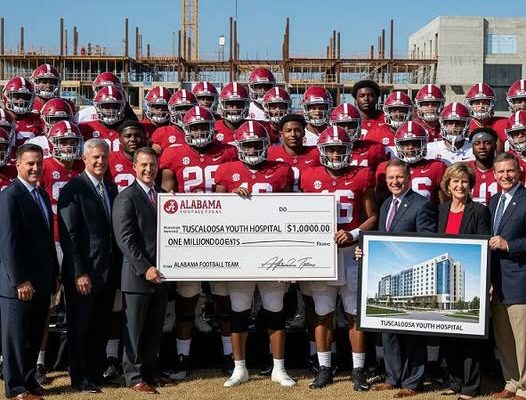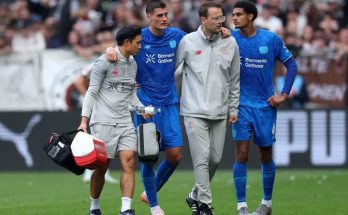**BREAKING NEWS: The entire University of Alabama football team announced they have collectively pledged a significant portion of their 2025 Name, Image, and Likeness (NIL) earnings to fund a new, state-of-the-art children’s hospital in Tuscaloosa. The unprecedented move, revealed at a press conference earlier today, has sent shockwaves through the sports world and beyond, redefining what it means for college athletes to leverage their fame for societal good.**
In an era where NIL deals have become a hotly debated topic—criticized by some for commercializing amateur athletics and praised by others for finally compensating athletes—the Alabama football team’s decision to pool resources for philanthropy marks a historic shift. Team captain and star quarterback Jalen Milroe spoke passionately about the initiative, stating, “We’ve been blessed with opportunities because of football, but this isn’t just about us. It’s about using our platform to leave a lasting impact on kids who need hope.”
The project, tentatively named **“The Crimson Hope Children’s Hospital,”** aims to address critical gaps in pediatric care across Alabama, particularly in rural areas where families often travel hours for specialized treatment. The hospital will focus on cutting-edge research for childhood diseases, including cancer and rare genetic disorders, while also providing comprehensive care regardless of a family’s ability to pay. Early estimates suggest the facility could cost upwards of **$150 million**, with the team’s initial commitments expected to cover a substantial portion. Additional funding will come from partnerships with local businesses, alumni donors, and a statewide public campaign.
Head coach Kalen DeBoer, visibly emotional during the announcement, praised his players’ leadership. “This isn’t something we coached them to do. They came to us with the idea, united as a brotherhood, and that says everything about who they are,” he said. The coaching staff and university administration have pledged to match a percentage of the players’ contributions, further amplifying the effort.
Reaction from the public has been overwhelmingly positive. Social media erupted with messages of support, while rival schools, including Auburn, commended the move. NCAA president Charlie Baker called it “a defining moment for college athletics,” hinting at potential policy adjustments to incentivize similar collective NIL philanthropy across other programs. Even political figures weighed in, with Alabama Governor Kay Ivey vowing to fast-track regulatory approvals for the hospital, calling the team’s gesture “Alabama at its best.”
But the decision wasn’t made lightly. Behind the scenes, players spent months in discussions with financial advisors, hospital administrators, and NIL experts to structure the donations responsibly. Some athletes, including those from underprivileged backgrounds, admitted the choice required personal sacrifice. “Yeah, I could’ve bought my mom a house,” said sophomore linebacker Jeremiah Alexander, “but she told me, ‘We’ve waited this long—imagine how many moms we can help now.’ That put it in perspective.”
Critics, however, question whether the move sets an unrealistic standard for other athletes. “Not every player has Alabama-level NIL opportunities,” argued sports economist Dr. Andrew Brandt. “While commendable, this could inadvertently pressure athletes at smaller schools to justify why they aren’t doing the same.” Others wonder if universities might exploit such initiatives to deflect from ongoing debates about revenue sharing with athletes.
Despite these concerns, the team remains focused. Their jerseys for the upcoming season will feature a patch with the hospital’s logo, and several players are already planning fundraising events, from charity auctions to youth football camps. The hospital’s design phase begins next month, with groundbreaking targeted for late 2026.
As the sun set over Tuscaloosa today, the story wasn’t about touchdowns or championships. It was about a group of young men who decided their legacy would be measured not in wins, but in lives changed. And in doing so, they may have just redefined the soul of college sports.
**Epilogue:** By the time this article publishes, #BamaForTheKids is already trending globally. ESPN reports that NFL stars and Alabama alumni—including Tua Tagovailoa and Derrick Henry—have privately reached out to join the cause. Meanwhile, in children’s wards across the state, doctors are answering questions from young patients about the “football players who are building them a new hospital.” One nurse shared, “For the first time in a long time, these kids aren’t asking when they can go home. They’re asking when they can meet the team.”
The power of sports, indeed.



